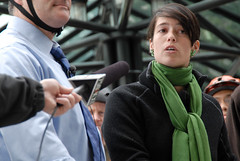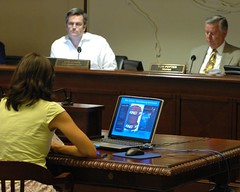Advocate Michelle Poyourow of the Bicycle Transportation Alliance (BTA) was one of over 70 people that testified in front of City Council at last week’s public hearing on the Columbia River Crossing project (CRC).
After the hearing, several people mentioned her testimony to me and I also noticed it referenced in a recap of the hearing in the Daily Journal of Commerce*. In the interest of sharing the perspective of the BTA on this massive project (both in size and importance to our region), I asked if we could reprint her testimony.
(*The DJC incorrectly reported that the BTA testified in support of a 10-lane bridge (which, as you can see from the testimony below, they did not). Poyourow has asked them for a correction.)
As you read her words below, notice that she never even mentions bicycles:
“…we do not believe some of the key claims that are being made by CRC staff and the DOTs about the effects of this project on our region.”
My name is Michelle Poyourow. I am an advocate for the Bicycle Transportation Alliance and our 5,000 members in Oregon and SW Washington.
Our members want us to pay attention to the Columbia River Crossing project because as taxpayers they want it to be a good investment; as neighbors they fear its potential to degrade their communities; and as workers and business owners they need it to move people and freight reliably, for a long time to come.
The BTA has dedicated a staff person to track CRC planning and to sit on a project subcommittee for the last 1 1/2 years. But we do not believe some of the key claims that are being made by CRC staff and the DOTs about the effects of this project on our region.
We believe the Columbia River Crossing can be built in a way that improves our economy and environment. But to do so, it must be BOTH designed AND tolled in a way that inhibits the ‘induced demand’ which usually accompanies new highway capacity of this magnitude.
What is ‘induced demand’? It can be described as a supply of something (in this case, road capacity) actually leading to more demand (in this case, traffic). We can all see what happened to the Glenn Jackson Bridge, which added lots of capacity, lacked any tolls, and accordingly induced sprawling new development – and therefore far more traffic – than the planners forecast.
That is why you must take the CRC projections with an grain of salt: highway planners have been wrong in their projections before, many times over. The Glenn Jackson Bridge is but one example of a growing history of road-expansion projects that were projected to relieve congestion but, once built, only generated more. Transportation infrastructure is different from other forms of infrastructure because the supply and demand influence one another: if we build more schools, people do not have more children; if we build more sewers, people do not use the toilet more; but if we build bigger roads, people DO drive more.
“The bottom line is that a major capacity expansion is on the table; more lanes across the river will move more traffic across the river, no matter what you call them.”
There are three flaws in the project staff’s current conclusions: one, they claim that a 12-lane bridge will not induce much more traffic, but their analysis rests entirely on the assumption of tolls – yet no agreement has been reached on tolls.
Two, the use of the term “add/drop” and “auxiliary” lanes is misleading. One of them is nearly five miles long! Many of the trips taken over this bridge even today are less than 5 miles long, but those trips are not “auxiliary” – they are real, and they eat up real road capacity. The bottom line is that a major capacity expansion is on the table; more lanes across the river will move more traffic across the river, no matter what you call them.
Three, although CRC staff and the state highway departments will tell you the projections were compiled by Metro, what they will not tell you is that Metro was instructed to hold land uses constant in all of those projections. So the question this Council asked last spring – ‘Will the new highway capacity lead to changes in land use, and thereby induce development and demand?’ – becomes a tautology: the planners say the new capacity will not change land uses only because they were told to assume no changes in land uses.
For your action on February 25th, we respectfully suggest that you tie any decision on the number of lanes to an agreement on tolling to manage demand and to balance auto, freight and transit use over the I-5 and I-205 bridges. To do otherwise would mean a bridge of ANY width is likely to become as gridlocked as the current six lane bridge, due to the induced demand that CRC staff have not included in their projections. And that is an outcome that would be bad for everyone.
Thank you.
There seems to be a lot of momentum right now for a 12-lane bridge. Even Portland City Commissioner Randy Leonard is beating the drum for 12 lanes. His support led The Oregonian editorial board — who are also in favor of a 12-lane span — to publish a pieced titled, Leonard leads way on I-5 bridge.
But today, The Oregonian has published (on their online-only “The Stump” section) a guest opinion piece by Metro Council president David Bragdon. In it, he writes:
“We want this project built, and we want it built in a manner that serves its purpose rather than defeats its purpose…
Again, my conclusion is that there is far more upside potential in this project than downside risk. But with all due respect, the boosters (and now your editorials and columns) have downplayed the risks of a “too big” bridge and their possible costs.”
— Browse our previous coverage of the Columbia River Crossing project. Also, read how the BTA’s stance on the CRC has evolved over time:



